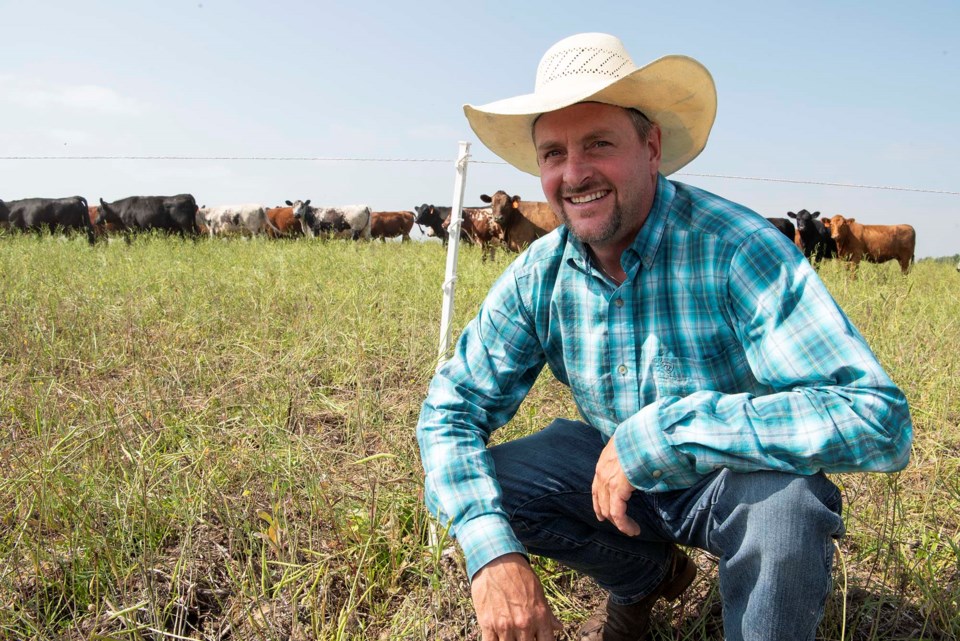How Now Green Cow
How Now Green Cow is examining how farms and food are shaping and being shaped by the climate crisis. Got a food and climate question? Send it to [email protected] so it can be addressed in a future story.
Delton Jubinville’s cows have an easy life at Luis Groot’s farm east of Gibbons. Every day, they roam about a roughly 40-by-400 metre paddock seeded with around a dozen grassy plants, munching on clover and turnips that can grow to the size of a human head.
Every two days, Luis takes down one of the thin electrified wires around the paddock to let the cows into a similarly sized but untouched one next door. Sensing greener pastures, the cows mosey on over to resume their lunch, leaving a trampled, relatively barren mess behind them. In the process, they grow faster, boost soil yields, and even help fight climate change.
“It’s regenerative agriculture at its finest,” Jubinville said.
Jubinville and Luis are practising rotational grazing — an agricultural technique that sees grazing animals concentrated in a small, frequently moved area. Researchers and farmers say rotational grazing can help turn cropland into carbon storage.
Simple, but it works
Farmer Emma Cross has been doing rotational grazing on her farm near Tofield for about a decade, as have many of her neighbours.
Conventional grazing sees farmers put cows in a field and let them eat what and where they want, Cross said. This lets the cows be picky, and can result in patches being overgrazed and less productive.
Rotational grazing sees farmers divide fields up into small paddocks ranging from 40 by 40 feet to an acre, typically with electric fences, Cross said. They then put all their cows into one paddock, have them graze the heck out of it over one or two days, then move them to the next. By the time the cows rotate back to the first paddock months or weeks later, it has regrown.
“Our land is our main resource,” she said, and rotational grazing helps to maintain its health.
“By allowing the grass to have more rest time, we allow it to regrow more over the growing season so that we have pasture and grass to work with for years to come.”
Jubinville said he partnered with Luis’s father, Wayne Groot, to do rotational grazing on the Groot grain/potato farm several years ago.
“Wayne wanted a way he could cut fertilizer costs,” Jubinville said, and figured a combination of cover crops plus grazing could do the trick.
The cows and cover crops are now part of the farm’s regular rotation, Jubinville and Luis explained, and have already produced results. The long roots of the cover crops aerate the soil and haul nutrients to the surface for other plants to use. The cows eat everything down the dirt, encouraging faster regrowth, and poop out valuable nutrients. Their hooves also churn up the soil and trample unwanted weeds.
“You want to mimic what the bison did years ago,” Jubinville said — they’d take one bite from an area then move on.
Luis said rotational grazing has increased the amount of organic matter in his fields and decreased the amount of fertilizer it needs for crops such as potatoes. Jubinville said his cows grow faster when they’re on these fields because of the varied diet and frequent exercise rotational grazing provides them.
“It’s a salad bar for the cattle!” he said of the fields.
University of Alberta ecologist Mark Boyce has studied rotational grazing and says it has great potential in the fight against climate change.
“Soil, especially grassland soil, holds an enormous quantity of carbon,” he said, and the grasslands of the western Great Plains are one of the biggest carbon stores on Earth.
Boyce said research by his team found land subject to rotational grazing stores slightly more carbon than conventionally grazed grassland because the grazing encourages more plant growth. It also breaks up the soil, allowing for more water infiltration and drought resistance, and encourages the growth of methane-eating microbes — significant, as methane traps about 28 times more heat per unit than CO2.
Boyce said a hectare of grassland managed with rotational grazing can sequester about two tonnes of carbon a year — impressive, given the size of the typical farm. Grow crops on that same land, and you release about half the carbon in it.
Economic barriers
Boyce estimated less than 10 per cent of Alberta farmers practise rotational grazing.
“It’s a fairly intensive process,” he said, and not everyone has the time to do it.
Economics deter farmers from this practice, as they can make more money by converting pasture to canola, Boyce said. He called on governments to create carbon registries to recognize and reward farmers who used rotational grazing to increase carbon storage in soil.
Rotational grazing is a long-term investment meant to help rebuild the soil, said Jubinville and Luis. They hope public education will make it more popular, adding they already get a lot of questions about it from their neighbours.
“We have some pretty amazing land out here in Sturgeon County,” Luis said.
“If these cows can help add value to it, if it allows us to farm here for 30 to 40 more years, that’s a pretty big thing for us.”



